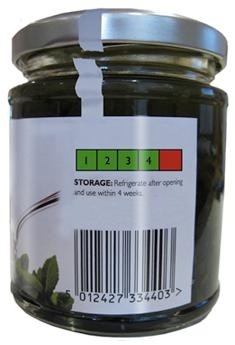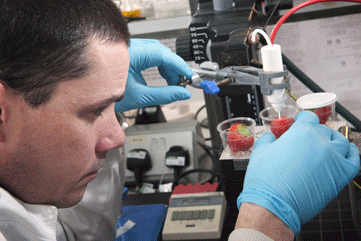Top food firms interested in novel food freshness label, entrepreneur

According to Strathclyde University research, around 8.3m tonnes of food are wasted in the UK every year, where consumers buy jarred or bottled products with a six-week shelf life, but forget how long it has sat in the cupboard or fridge and throw it away.
Pete Higgins from Liberton-based UWI Label told FoodManufacture.co.uk that his firm’s patent-pending system – which has been nominated for a John Logie Baird scientific innovation award – uses chemical means taken from another industry to ascertain how fresh food is.
Elapsed time indicator
UWI’s label (pictured) which is integrated into labelling, has a green strip that indicates food age in weeks on a scale of 1-4. Once reached, a red square at the end indicates that the food is no longer edible. The product is unique, Higgins said, because it is the only one he knows of that users an ‘elapsed time indicator’ to trigger a time device when the product is opened.
UWI Label developed the technology over three years with help from Heriot Watt University, said Higgins, with the firm initially developed an electronic prototype, then an electronic/chemical hybrid, before settling on a wholly chemical indicator:
“The boon of the product is that it withstands temperature changes, and is equally effective in both the cupboard and fridge: electronics are more costly and sensitive to temperature changes.”
Frustration at grant situation
Asked about parallels with an ongoing Strathclyde University study - the subject of a £325,000 government enterprise grant in January - to develop indicators made from ‘intelligent’ plastics that can be incorporated into foods (most notably seafood and meat) Higgins added:
“It very frustrating, since I run a private company we don’t have access to public funds for research. I’ve invested around £50,000 of my own money and have to pay for everything myself, bar the odd grant here and there. But we are in roughly the same space as Strathclyde.”
Higgins says his label, which reportedly doesn’t work on tins, is “adaptable to so many markets, so the potential is huge, but the problem just now is the price point. The pharmaceutical market can stand a higher initial price point, and economies of scale lessen the cost later on”.
He added that UWI was talking to two major, unnamed food manufacturers about investing in the product: “It’s more difficult to get into the food market, but we are also in discussions with a major supermarket and the product is attractive to them: supermarkets spend millions on loyalty and branding, but can’t be seen to profit from consumer wastage.”
Win-win scenario for retailers
If this were reduced significantly, Higgins added, then it was a win-win situation for retailers, consumers and UWI Label itself. Given that the label would only costs only “a few pence”, he believes that retailers or major food firms would be willing to absorb or at least split the slight price premium the indicator would involve, given the positive sustainability message the product would allow them to make.
Higgins said the label could be used on food packaging within 12-18 months, if investment plans progress and his firm ties-up with a major commercial partner, although he predicts penetration into the pharmaceutical market by the end of the year, where the label can also be used on medicine bottles, pills and cosmetics.














